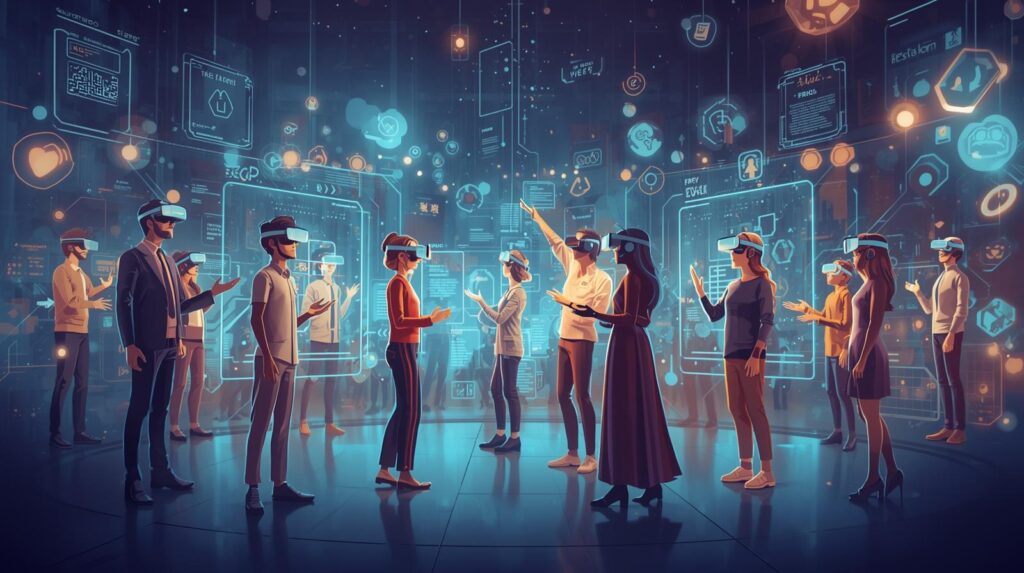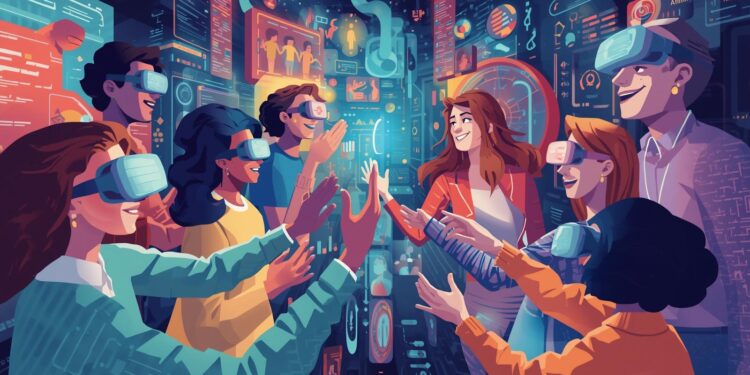Virtual reality (VR) is no longer a futuristic concept confined to science fiction. Today, it is a burgeoning field that is significantly altering the landscape of social interaction. As a thought leader in technological innovations, I am excited to explore how VR is transforming our social lives and what this means for industries and individuals alike.
In this article, we will delve into the impact of virtual reality on social interaction, exploring the rise of social VR games and their implications for the future. We will also discuss the challenges and opportunities that VR presents, offering insights for Chief Technology Officers, Business Strategists, and Innovation Managers looking to harness this technology’s potential.
Virtual reality has introduced a new dimension to social interaction by creating immersive environments where people can connect, communicate, and collaborate. Unlike traditional digital communication, VR allows users to engage in experiences that mimic real-life interactions, complete with spatial presence and a sense of embodiment.
One of the most fascinating developments in the VR landscape is the rise of social VR games. These platforms enable users to meet in virtual spaces, participate in activities, and build relationships just as they would in the physical world. Games like VRChat, Rec Room, and AltspaceVR have gained significant popularity, providing users with a playground for socialization that transcends geographical boundaries.
Social VR games are not merely about gaming; they are about creating shared experiences. Users can host virtual events, attend concerts, or simply hang out with friends in a virtual setting. This versatility makes social VR games a powerful tool for fostering community and connection in an increasingly digital world.
The integration of VR into social interaction has profound implications for businesses and strategists aiming to leverage this technology for growth and innovation.
For Chief Technology Officers, VR presents an opportunity to enhance business operations by integrating immersive technologies into their strategies. Virtual reality can be used for training, simulations, and remote collaboration, enabling teams to work more efficiently and effectively, regardless of their physical location.
Moreover, VR can enhance customer engagement by offering unique and immersive experiences. Retailers, for example, can use VR to create virtual showrooms, allowing customers to explore products in a 3D environment before making a purchase.

Business Strategists must navigate the challenge of aligning technological advancements with business goals. Virtual reality offers new avenues for growth, but its implementation must be strategic. By developing plans that incorporate VR into broader business objectives, strategists can create competitive advantages and drive innovation.
Innovation Managers are tasked with identifying and implementing transformative technologies. VR’s potential to revolutionize social interaction makes it a prime candidate for fostering innovation within organizations. By experimenting with VR applications, companies can explore new ways to engage customers and create value.
While the potential of VR in social interaction is immense, it is not without challenges. Understanding these challenges is crucial for those looking to integrate VR into their strategies.
Despite advancements, VR technology still faces technical limitations. High-quality VR systems require significant computing power and specialized hardware, which can be a barrier to widespread adoption. Additionally, issues such as motion sickness and limited content availability can impact user experience.
As with any digital platform, privacy and security are critical considerations in VR environments. Ensuring user data protection and preventing unauthorized access are essential for building trust and encouraging adoption.
The introduction of VR into social spaces raises important social and ethical questions. How do we ensure equitable access to VR technology? What are the implications for mental health and social behavior? These questions require thoughtful consideration as VR becomes more integrated into our daily lives.
The potential for virtual reality to reshape social interaction is vast and varied. As VR technology continues to evolve, it will open up new possibilities for how we connect and communicate.
In the future, VR could enable even more immersive social experiences. Imagine attending a virtual family gathering, participating in a global conference, or exploring a new city with friends, all from the comfort of your own home. These possibilities expand our social horizons and create opportunities for richer, more meaningful interactions.
For businesses, the continued development of VR offers opportunities to drive innovation and create competitive advantages. Companies that embrace VR’s potential can differentiate themselves by offering unique experiences that captivate and engage audiences.
As we move toward a VR-driven world, it is essential for industry leaders to stay informed and prepared. By understanding the potential and limitations of VR, Chief Technology Officers, Business Strategists, and Innovation Managers can make informed decisions that position their organizations for success in this evolving landscape.
Virtual reality is transforming social interaction in ways we are only beginning to understand. Its impact on business strategy and innovation is profound, offering new opportunities for growth and engagement. As we navigate this exciting frontier, it is essential to balance the potential benefits with the challenges and ethical considerations that come with it.
By staying informed and proactive, industry leaders can harness the power of VR to create a more connected, immersive, and innovative future. Whether you’re a CTO, Business Strategist, or Innovation Manager, understanding VR’s role in social interaction is key to driving success in the digital age.




